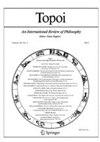亚当·斯密的道德情操论
IF 1.3
2区 哲学
0 PHILOSOPHY
引用次数: 0
摘要
摘要本文从亚当·斯密的《道德情操论》中归纳出至少六种不同的同胞情感。这六种类型是:(1)情绪的镜像;(2)利他主义;(iii)判断情绪/动作的音高;(iv)判断情绪/行动的价值;(v)友谊和爱;(六)引起钦佩的渴望。史密斯并没有把它们并排列出。这个并列的清单有望帮助思想家了解如何将它们组合起来,以构建一个连贯和系统的框架,来整合行为的三个时刻:情感、理性和道德。本文章由计算机程序翻译,如有差异,请以英文原文为准。
Adam Smith’s Theory of Moral Sentiments
Abstract This review identifies at least six different kinds of fellow-feeling in Adam Smith’s Theory of Moral Sentiments. The six kinds are (i) the mirroring of emotions; (ii) altruism; (iii) judgment of pitch of emotions/actions; (iv) judgment of merit of emotions/actions; (v) friendship-and-love; and (vi) aspiration that leads to admiration. Smith does not list them side-by-side. This side-by-side listing promises to help thinkers to see how to assemble them to construct a coherent and systematic framework on how to amalgamate three moments of behavior: the emotional, the rational, and the moral.
求助全文
通过发布文献求助,成功后即可免费获取论文全文。
去求助
来源期刊

TOPOI-AN INTERNATIONAL REVIEW OF PHILOSOPHY
PHILOSOPHY-
CiteScore
3.10
自引率
7.10%
发文量
47
期刊介绍:
Topoi''s main assumption is that philosophy is a lively, provocative, delightful activity, which constantly challenges our received views, relentlessly questions our inherited habits, painstakingly elaborates on how things could be different, in other stories, in counterfactual situations, in alternative possible worlds. Whatever its ideology, whether with the intent of uncovering a truer structure of reality or of soothing our anxiety, of exposing myths or of following them through, the outcome of philosophical activity is always the destabilizing, unsettling generation of doubts, of objections, of criticisms. It follows that this activity is intrinsically a ''dialogue'', that philosophy is first and foremost philosophical discussion, that it requires bringing out conflicting points of view, paying careful, sympathetic attention to their structure, and using this dialectic to articulate one''s approach, to make it richer, more thoughtful, more open to variation and play. And it follows that the spirit which one brings to this activity must be one of tolerance, of always suspecting one''s own blindness and consequently looking with unbiased eye in every corner, without fearing to pass a (fallible) judgment on what is there but also without failing to show interest and respect. Topoi''s structure is a direct expression of this view. To maximize discussion, we devote most or all of this issue to a single topic. And, since discussion is only interesting when it is conducted seriously and responsibly, we usually request the collaboration of a guest-editor, an expert who will identify contributors and interact with them in a constructive way. Because we do not feel tied to any definite philosophical theme (or set of them), we choose the topic with absolute freedom, looking for what is blossoming and thriving, occasionally betting on what might - partly through our attention - ''begin'' to blossom and thrive. And because we do not want our structur e to become our own straightjacket, we are open to contributions not fitting the ''topos'', and do not rule out in principle the possibility of topic-less issues.
 求助内容:
求助内容: 应助结果提醒方式:
应助结果提醒方式:


